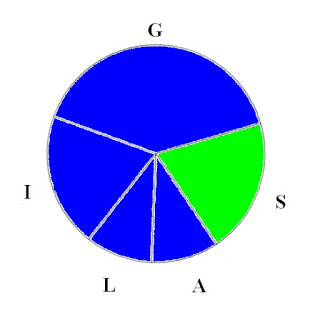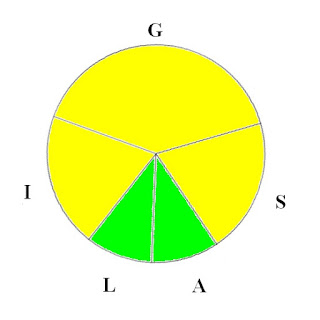Now I know what you're thinking. "It's a pie chart, Rayze. You didn't make it."

Well hold on to your butts, because this isn't just any pie chart. This is my own, personal method of reviewing games using nothing but a single image. I call it a GISLA Circle, and the circle itself is representative of a single video game as a whole. The G takes up 40% of the game, the I and the S each 20%, and the L and A each 10%. These five categories are the ones that I feel best encompass everything that a video game can, and should, be, with their different weights being their relative importance. The five categories are as follows:
Gameplay, 4 Points
Immersion, 2 Points
Story, 2 Points
Looks, 1 Point
Audio, 1 Point
Each category will be given a score between 1 and 5, with these scores being color coded as follows:
Red - Done poorly to the point of being detrimental or distracting, x0 Multiplier
Orange - Below standards and off-putting, x0.25 Multiplier
Yellow - Par for the course, equal balance of good or bad, or nonexistence in a way that is not detrimental to the final product, x0.5 Multiplier
Green - Above standards, generally well done, x0.75 Multiplier
Blue - Exceptionally well done, well above industry standards, x1 Multiplier
With this system, the closer the circle is to being completely blue, the higher recommendation the game gets. The warmer and more red the circle is, the less recommendable it is. With this system, not only can the gamer easily identify at a glance the reviewer's general opinion on the package as a whole, but their eyes can easily shift towards whichever category is most important to them, allowing them to see instantly how it fares in that category. Using each category's point allowance, and the color coordinated multipliers, the game can then also be given an overall score between 0 and 10, in multiples of 0.25, to effectively tell the reader how successful the game is as a whole.
So, some examples.
Well, this game is all over the place, isn't it? Let's break down what we're looking at with the above GISLA Circle:
Gameplay - Amazing, the reviewer has little to no complaints and feels that the gameplay went above and beyond.
Immersion - Not only did the reviewer find the game impossible to immerse themselves into, they found themselves being forcefully taken out of the experience.
Story - The reviewer really enjoyed the game's story and characters, but either found some flaws with them or didn't feel that they went the extra mile or did anything too special with them.
Looks - This game had some unimpressive graphics, probably including annoying drops in framerate and a lack of anti-aliasing, but only enough to be annoying,
Audio - The sound design was fine, it did its job and didn't detract from anything, but nor was it particularly memorable. That, or the game features very little audio, but the lack-there-of didn't bother the reviewer.
Gameplay is worth 4 points, and Blue is a x1 Multiplier, so 4 points for G.
Immersion is worth 2, but Red yields x0, so 0 points for I.
Story is worth 2 as well, and Green gives x0.75, so 1.5 points for S.
Looks is a 1 pointer, and with the x0.25 bonus for Orange, gets 0.25 points for L.
Audio is the other 1 point category, with the neutral x0.5 for Yellow, meaning 0.5 points for A.
We add our points together now: 4 + 0 + 1.5 + 0.25 + 0.5 = 6.25
Final Score: 6.25/10, a game with fantastic gameplay and a great story, but a huge lack of general presentation that keeps it from being a highly recommendable experience.
Of note, though, is that this scale puts 5/10 as "average." A game that is completely inoffensive, yet unmemorable, that doesn't do anything necessarily right or wrong, would be a solid yellow circle and a 5. Let's look at some less balanced, more realistic examples, this time in reference to actual games.
This is my GISLA Circle for Donkey Kong Country: Tropical Freeze. I found the base gameplay near flawless, while going above and beyond with its difficulty curve and boss battle designs. The environments kept me incredibly immersed, the graphics were awe-inspiring with a gorgeous art style, and the music in the game was absolutely phenomenal. The story, meanwhile, served its purpose well, giving me good motivation to keep going and keeping me intrigued, but never really giving that extra detail into the game's main enemies or their plan that might have made for a more memorable storyline.
4 points for G, 2 for I, 1.5 for S, 1 for L, and 1 for A, and Tropical Freeze gets a GISLA Score of 9.5/10.
As much as I'd love to say that this is my GISLA for Pac-Man, this is actually my GISLA for a much earlier game, that good old classic Pong. Gameplay was simple and nothing to write home about, and there really wasn't much in terms of Immersion or Story, but their lack of presence wasn't to any negative effect. However, the game's simple art direction, and perfect hit detection, lead to a unique and memorable art style that remains burnt into our memories, getting the job done better than was ever needed for the time. Meanwhile, the game's sound design was just right, giving off great auditory queues and, again, being memorable and pleasant. See, the game's lack of scale and variety is decided in that top 40%, with the other categories being a reflection of "for what it is," and for what Pong is, it really does do its visual and audio designs quite well.
2 points G, 1 point I, 1 point S, 0.75 points L, 0.75 points A. Pong gets a GISLA Score of 5.5/10, giving one of the most basic and inoffensive games there is a damn near perfectly neutral score. It's little experiments like these that made me really start to like this scale. Alright, one more example.
Meet my GISLA for Bomberman: Act Zero. The gameplay was downright horrendous, featuring a complete lack of game modes, especially for its franchise, and having an overall disgusting difficulty curve with horrendously programmed A.I. that seem designed specifically just to piss you off. No fun can be extracted from its gameplay. The overly clichéd setting with no clearly defined purpose was near impossible to immerse oneself in. The story was almost nonexistent, and quite frankly the game would have been better if it was cut completely. Instead, we get some half-assed "explanation" about escaping to the surface because... PopTarts. The game's graphics aren't exactly impressive, nor are they grating, but what really brings the "Looks" category down is the laughably bad art direction. At least the game was forgettable in the auditory department, not standing out in any real way, but also being the only category where it didn't actively shoot itself in the foot.
0 G, 0.5 I, 0.5 S, 0.25 L, 0.5 A. Bomberman: Act Zero's GISLA, then, is a 1.75/10.
I hope you've got it down, now, because the explanations are done. And hey, you also got 3 very concise reviews with it! Future, full-article reviews will, of course, go into each category individually and to a much greater depth. I'll also be sure to include concluding paragraphs, which may or may not agree with the GISLA's perceived recommendations. I hope that this system of review scores is helpful, and I hope that it's as fun to see as it was to make. Until next time!
Waka waka waka waka waka waka waka waka






No comments:
Post a Comment